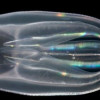Вопросы отсюда Mouritsen H (2018) Long-distance navigation and magnetoreception in migratory animals. Nature 558:50-59. doi: 10.1038/s41586-018-0176-1
The questions listed below represent some of the most important
The questions listed below represent some of the most important
open mechanistic questions for the next two decades of long-distance
navigation and magnetoreception research.
1. How do the magnetic senses work on the biophysical,
biochemical, and molecular levels?
2. Does quantum biology exist (that is, is magnetic sensing truly
quantum in at least some animals)?
3. What are the explanation for and ecological consequences
of the extraordinary sensitivity of the bird’s magnetic compass to
disruptive anthropogenic electromagnetic fields?
4. How does the light-dependent magnetoreception mechanism
distinguish between changes in light intensity and magnetic
direction, and how does it collect enough reaction statistics to detect
magnetic directions under low light conditions?
5. Do some animals use electromagnetic induction to detect the
geomagnetic field?
6. Do magnetic particles exist inside cells at consistent and
specific locations in many individuals of any migratory animal, and
are the particles associated with the nervous system?
7. How, if at all, can slow-moving animals distinguish the spatial
magnetic signal from temporal geomagnetic field variation to allow
for a magnetic map with a resolution below 10–30 km?
8. Where and how is magnetic information sensed and
processed?
9. Where in the brain, and how, is multisensory navigational
information integrated and weighted?
10. How do processing strategies in the nervous system transition
between the different phases?
11. How does the brain deal with conflicting and/or incomplete
information, and does this depend on the ecological conditions and/
or the navigational phase?
12. Do place and grid cell equivalents exist as neural correlates of
the map over scales of kilometres or even thousands of kilometres,
and, if yes, which cues contribute to their establishment?
13. Do equivalents of head direction cells exist that code for
celestial and/or magnetic compass direction on a regional or global
scale?
14. How is the very slow rotation of the stars detected?
15. How do small animals moving in air or water detect the
direction of flow even though they are embedded in the flowing
medium themselves?
16. Which genes trigger migration behaviour and/or code for
migratory direction and distance?
17. Exactly what cues signal to an animal that it should start
migrating or that it has reached its destination and should terminate
migration?
18. What determines when an animal switches from one
navigational phase to the next?
19. How is longitude (east–west) position determined on a
regional or even global scale?
20. How does the pinpointing-the-goal phase work in a monarch
butterfly or Bogong moth, which can pinpoint their very specific
wintering locations even though they have never been there before?
от себя несколько вопросов (для компенсации magnetoreception bias)
21. Does olfactory navigation exist or impaired navigational performance in anosmic birds is a side effect (such as the consequences of impaired place cells performance in hippocampus)
22. If the latter does exist how can changable olfactory information provide positional information?
23. To what extent different animal phyla developed similar mechanism for spatial cognition and which mechanisms differentiate animal taxa?
24. Do animals use the theoretically suggested cognitive map or they cope with navigation with more simpler approaches that do not require the eixtence of fully integrated cognitive map?
от себя несколько вопросов (для компенсации magnetoreception bias)
21. Does olfactory navigation exist or impaired navigational performance in anosmic birds is a side effect (such as the consequences of impaired place cells performance in hippocampus)
22. If the latter does exist how can changable olfactory information provide positional information?
23. To what extent different animal phyla developed similar mechanism for spatial cognition and which mechanisms differentiate animal taxa?
24. Do animals use the theoretically suggested cognitive map or they cope with navigation with more simpler approaches that do not require the eixtence of fully integrated cognitive map?



Комментарии (0)